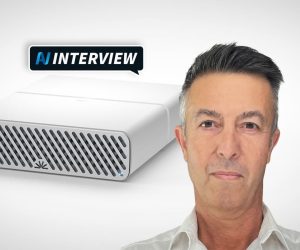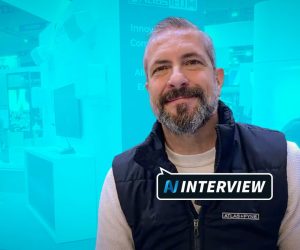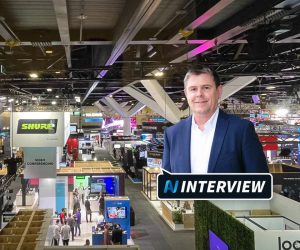
AV Interview: Jordan Christoff, Visionary Solutions
CTO of AVoIP specialists, Visionary, talks about what makes his company tick and its technology differences.
Interview:/ Christopher Holder
Visionary Solutions’ systems have ended up in some impressive projects over the years. The international Space Station is a stand out, though. A Visionary IPTV system has been in orbit, ticking away for the last 10 years. Which is all to say, Visionary has a lengthy and impressive track record of being involved in many a mission critical project. Visionary’s distribution has changed in Australia, so I thought I’d catch up with its CTO at the ISE show to get to know the company a little more.
AV: What’s Visionary’s origin story?:
Jordan Christoff: We started Visionary in 1995 – myself and another founder who’s no longer with the company. We were doing medical and military vision systems, including digital X-ray cameras and the like. But I was always interested in convergence, so in 1998 we began our first AV-over-IP product design, which came out with in 2002. It was a beautiful product called the AVN100. It was capable of standard def video using JPEG, run by our own operating system and stack. Unfortunately, no one wanted it because it loaded 70 megabits on the network and was doing multicast. So a couple of years later, we came out with a very successful product called the AVN200, which was based on MPEG2, and we stayed in the IPTV space until 2015. Then with the acquisition of SVSI by AMX, some of the distribution channel came to us and said, ‘hey, do you know anything about AV-over-IP?’ And we said, ‘yeah, we were doing it way, way back’. And so we came out with our 4000 series and then, at ISE 2017, we came up with a product that involved true Dante integration. That’s been the space we’ve been innovating in ever since.
I think that’s one of our real strengths: having both a networking background and video background in the same company. One of our guys used to design network switches, so I think Visionary is one of the few, maybe the only company, where we’re not a networking company that started doing video or a video company that started doing networking. We’ve always had both. And our goal is to provide the solution to the customer, including support and design help.
AV: Mostly product like yours isn’t sold on superior video quality or better latency – at least not any more. What’s your special sauce?
Jordan Christoff: We try to optimise the design choices for the customer; help them make the best trade offs. For example, we really are centred around 1Gb PoE because it’s currently the sweetspot. 10Gb increases the cabling requirements and it’s harder to scale in terms of uplinks.
Now with the latest codecs, you can provide a 4K60 4:4:4 image at 1Gb with one frame of latency, and true network integration. That covers a large section of the application space. Sure, for true broadcast, then SMPTE ST2210 might be more suitable but for the 80th percentile of the market, which is what we try to serve, we think our offering is really optimised.
Another thing is the power footprint of our products. Our wallplates draw about 7W, while our most power-hungry product might be only 12W. So it’s different to our competitors’ ‘heavy iron’ solutions that have a fan and require PoE+ or PoE++. We’re making every effort to be a true embedded end point.
AV: PoE and PoE+ is proving to be an installers best friend.
Jordan Christoff: All of our encoders are capable of running on PoE. If you give some of our encoders PoE+ they can send it through. We have a PoE+ amplifier, which was the first PoE+ Dante/AES67 amp, something we’ve been building since 2014.
AV: How is the rise of USB3 in meeting rooms, especially, impacting your product designs?
Jordan Christoff: USB-over-IP is is really quite important. Zoom and Teams has really exploded. They’re largely USB based but without any concept of how to extend that USB. Maybe within a room you can use point-to-point extenders but as you start to grow the system, USB-over-IP becomes really important. We had some of the first endpoints doing DisplayPort Alt Mode ingest on the encoder over the USB-C connector, then true UVC output from our decoders, and now we have isochronous. All this is important to UC workflow.
AV: For those in Australia unfamiliar with your product, how would you describe Visionary’s personality. Seems like you’re a smart outfit?
Jordan Christoff: I prefer the term ‘knowledgeable.’ There are a lot of smart people in the industry but I think the difference is that we are very customer focussed. Everyone says that but you’ve got to find that out for yourself, right? Everyone says they have great support but we have a lot of satisfied customers who know we do. It’s the type of help that doesn’t just stop with the extent to which Visionary is involved in your design. If we can help, we will help – we’re here to actually solve your overall problem. Network audio video is our company sub tag, and the network is really the most important thing. But it’s a complicated space. It’s getting easier thanks to Netgear’s AV switches. We have a nice profile with them.
AV: Seems like Netgear is serious about taking a lot of that heavy lifting away from AV people when it comes to networking.
Jordan Christoff: It’s really interesting. When Netgear was first talking about getting into this industry, Scott Freshman, our COO, was talking with their guys saying, ‘you have a lot of work to do because Netgear is perceived as a consumer brand’. But they’ve changed those perceptions and more. A company like Netgear has a lot of things to juggle, especially in the network audio space. They need the PTP to be really strong and the QoS, which they’ve done. We’ve worked really closely with Netgear on a Visionary profile. And I think it does make things a lot easier. Actually, we have some really exciting things coming up later this year that expands on what we can do with the Netgear switch.
AV: Thanks for your time here at ISE, Jordan.
Jordan Christoff: No problems. I would just like to leave people with the the idea that a lot of people who’ve tried Visionary never go back to something else. So, give us a shot!















RESPONSES